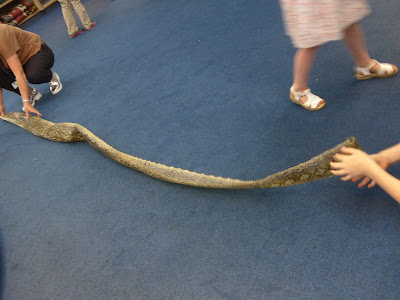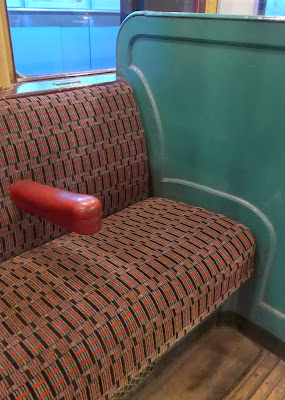On the strength of my post 'Tate Britain from the Floor', which you can see here, I was invited to do a Twitter Tour for the Barbara Hepworth exhibition at Tate Britain for the @tate_kids account.
So today I took over the @tate_kids account and tweeted our visit, a virtual tour of the exhibition, sharing our family's experiences. I say 'family', we also took a friend, nine year old charlie. So here's my tour, as you can see it's not my Twitter account, it's the Tate Kids, but it's all me.
The lovely @art_e_facts and her family are doing a special Twitter tour of the #Hepworth exhibition at noon GMT - stayed tuned!
— Tate Kids (@tate_kids) August 19, 2015
At Barbara Hepworth exhib-12yr old straight into taking panoramics of 'Carving'-work more figurative than I expected pic.twitter.com/OKLx866XcY
— Tate Kids (@tate_kids) August 19, 2015
Sculpture animals are popular with the kids, especially the Toad. #BarbaraHepworth @Tate Britian pic.twitter.com/32TErt5jdR
— Tate Kids (@tate_kids) August 19, 2015
Seeing things in abstract shapes "Watermelon & an orange". We all like this piece. #BarbaraHepworth @Tate Britain pic.twitter.com/0iAL3FiRcq
— Tate Kids (@tate_kids) August 19, 2015
Carving looks difficult "if you make a mistake you can't fix it" "except that one looks like it's made of fudge" pic.twitter.com/sPGuAylfH7
— Tate Kids (@tate_kids) August 19, 2015
Watching the film, we see that carving does indeed look very physical. #BarbaraHepworth TateBritain #NotFudge pic.twitter.com/vFTLJ3wJKB
— Tate Kids (@tate_kids) August 19, 2015
Barbara Hepworth sculpture looks very different from different angles. Kids took these photos not me-@art_e_facts pic.twitter.com/mTo2nxEroc
— Tate Kids (@tate_kids) August 19, 2015
Kids find the smallest things in galleries intruiging. "What's that?" We can see it's a thermometer "but what for?" pic.twitter.com/idd9T0xJYn
— Tate Kids (@tate_kids) August 19, 2015
Age 9-42 we all love the film. Helps us "get it", her work & ideas. "Cool music" and liked "the way it looked" pic.twitter.com/jEAAzfnRnY
— Tate Kids (@tate_kids) August 19, 2015
"Oh yeah!" We all get the link with Hepworth's work and the sea. My kids (@art_e_facts) response after the film. pic.twitter.com/ULzuA7ZsbN
— Tate Kids (@tate_kids) August 19, 2015
So it's not just us! 12yr old can't resist a photo through her sculpture-We've all done it, surely? #BarbaraHepworth pic.twitter.com/e5NGjdBexP
— Tate Kids (@tate_kids) August 19, 2015
Taking photos of art. Kids using apps on their mobiles #CartoonSetting #BarbaraHepworth pic.twitter.com/lfJT5lluMT
— Tate Kids (@tate_kids) August 19, 2015
"I've found my favourite, there were books to look at, they were all different" Age9 #BarbaraHepworth @kidsinmuseums pic.twitter.com/vc9ILTXllc
— Tate Kids (@tate_kids) August 19, 2015
"They look like learning maths shapes at school" age12 #BarbaraHepworth was fascinated by mathematical models @Tate pic.twitter.com/jOiXJBhTwH
— Tate Kids (@tate_kids) August 19, 2015
kids moved on from "what is it?" to understanding her influences, "holes in rocks & boulders by the sea" #Hepworth pic.twitter.com/bMRmJV2Ypg
— Tate Kids (@tate_kids) August 19, 2015
Not all #Hepworth work is found in exhibition #SculptureForAModernWorld Kids found this in permanent galleries #Tate pic.twitter.com/2BwDwKQxBU
— Tate Kids (@tate_kids) August 19, 2015
Ended visit in Tate cafe. Kids took Hepworth influenced photos of the ceiling in there #SmoothShapes #ShapesInshapes pic.twitter.com/s3fuMMzCd2
— Tate Kids (@tate_kids) August 19, 2015
Thanks @tate_kids for letting us share our family tour of #BarbaraHepworth exhibition-We had a grt time @art_e_facts pic.twitter.com/br9ez2B6Nn
— Tate Kids (@tate_kids) August 19, 2015
Barbara Hepworth: Sculpture for a Modern World is on at Tate Britain until 25th October 2015. Details on their website, here.
It is a paying exhibition and I have to thank Tate Britain for inviting us to see it.
Update: I made a mistake. I have to admit I'm not 42. In all the excitement, I knocked a few years off my age. Thanks to a lovely friend who felt she had to point this out.
Update: I made a mistake. I have to admit I'm not 42. In all the excitement, I knocked a few years off my age. Thanks to a lovely friend who felt she had to point this out.








































































